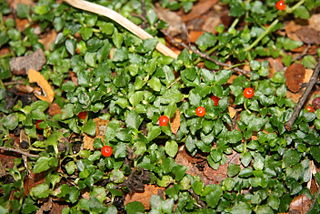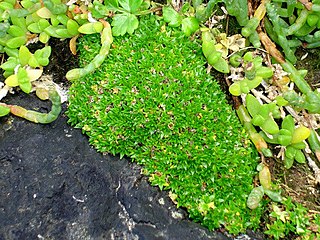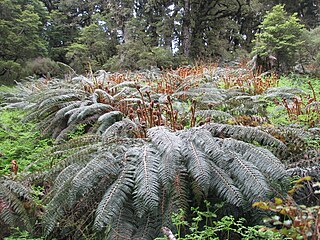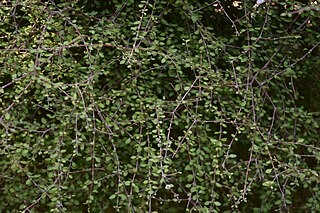
Coprosma is a genus of flowering plants in the family Rubiaceae. It is found in New Zealand, Hawaiian Islands, Borneo, Java, New Guinea, islands of the Pacific Ocean to Australia and the Juan Fernández Islands.

Nertera is a genus of about 15 species of flowering plants in the family Rubiaceae, native to the Southern Hemisphere, in South America and Australasia, with one species extending into the Northern Hemisphere in Central America, eastern Asia, and Hawaii. The name derives from the Greek word nerteros, meaning low down. Common names include pincushion, coral bead or bead plant. They are prostrate, creeping, mat-forming herbaceous perennial plants growing to 20–40 cm (7.9–15.7 in) across or more but no more than a few centimetres high. The leaves are usually quite small, and when crushed may in some species release a foul smell (methanethiol) like the related woody genus Coprosma. The flowers are insignificant and probably wind-pollinated. The fruit is usually a bright orange berry, but in some species may be a dry capsule.

Coprosma repens is a species of flowering shrub or small tree of the genus Coprosma, in the family Rubiaceae, native to New Zealand. Common names include taupata, tree bedstraw, mirror bush, looking-glass bush, New Zealand laurel and shiny leaf.

Coprosma quadrifida is a dioecious shrub of the family Rubiaceae native to southeastern Australia. First described as Canthium quadrifidum by Labillardiere, it was given its current name by B. L. Robinson in 1910. Typically found at damp sites within woodlands, Eucalyptus forests or cool-temperate rainforests, it prefers sheltered slopes or sites near water sources. They are able to withstand frost and are salt tolerant. The species is also known as the Prickly Currant Bush.

Coprosma nitida, the mountain currant or shining currant, is a shrub species endemic to south-east Australia. It is a shrub with small, glossy leaves, occasional spines on the end of its branchlets, and small bright red-orange fruits.

Colobanthus muscoides is a low-growing, moss-like flowering cushion plant in the family Caryophyllaceae, found on islands in the south-western Pacific Ocean, especially in the subantarctic region. The specific epithet comes from the Latin muscus (moss) and -oides (resembling), with reference to its growth habit.

Polystichum vestitum, commonly known as the prickly shield fern or pūnui (Māori), is a hardy, evergreen or semi-evergreen ground fern.

Cardamine corymbosa, commonly known as the New Zealand bitter-cress, is a flowering plant in the family Brassicaceae. Native to the subantarctic islands of Australasia, it has become an invasive species in plant nurseries. The specific epithet refers to the structure of the inflorescence.

Agrostis magellanica is a species of grass. It has a circumpolar distribution and is native to many subantarctic islands in, and the coasts bordering, the Southern Ocean.

Juncus scheuchzerioides is a species of rush variously called short rush or greater rush. It has an Antarctic circumpolar distribution and is native to many subantarctic islands in, and on the regions bordering, the Southern Ocean.

Leptinella plumosa is a small flowering plant in the daisy family. It is a circumantarctic species found on many subantarctic islands in the Southern Ocean. The specific epithet comes from the Latin for “feathery”, referring to the form of the leaves.

Coprosma autumnalis or C. grandifolia according to earlier Colenso authority, is a native forest shrub of New Zealand. Its widespread in both the North and South Islands, and has the largest leaves of any New Zealand coprosma.

Acaena minor is a species of flowering plant whose range is confined to Australia's subantarctic Macquarie Island and to New Zealand's Campbell and Auckland Islands in the Southern Ocean.

Galium antarcticum, commonly known as Antarctic bedstraw or subantarctic bedstraw, is a species of flowering plant in the coffee family. It has a largely subantarctic range.

Coprosma huttoniana is a flowering plant in the family Rubiaceae. The specific epithet honours Ian Hutton, the Lord Howe Island based naturalist who discovered the plant and recognised it as a new species.
Coprosma inopinata is a flowering plant in the family Rubiaceae. The specific epithet comes from the Latin inopinus (“unexpected”), because it was discovered unexpectedly in 1989, proving to be yet another species of Coprosma that was endemic to Lord Howe Island.

Coprosma hirtella is a shrub in the family Rubiaceae. It is endemic to south-eastern Australia. It grows to about 2 metres high and has leaves that are between 15 and 50 mm long and 10 to 25 mm wide. Plants have male and female flower clusters that appear between August and April. These are followed by orange to reddish fruits that are 7 to 8 mm in diameter.

Coprosma virescens is an endemic New Zealand plant in the genus Coprosma of the family Rubiaceae. Its Māori name is mingimingi, a name which is also applied to closely related species such as C. dumosa, C. rhamnoides, C. propinqua and C. crassifolia. It is a small-leaved shrub or tree which grows 2 to 3 metres high. It has very slender, more or less glabrous divaricating branches. The small leaves are petiolate with petioles from 2mm to 5mm long. The leaves narrow suddenly at the petiole and may be up to 9 millimetres (0.35 in) long and 6 millimetres (0.24 in) wide with wavy margins or a few blunt teeth throughout South Island in lower montane forest and scrubland. The apetalous male flowers occur in axillary clusters of one to two on very short branches. Female flowers are found on their own at the ends of short branchlets.

Juncus antarcticus, also known as dwarf rush, is a flowering plant species in the rush family Juncaceae, native to New Zealand and Australia.

Coprosma niphophila, the creeping coprosma, is a shrub native to Australia and the south island of New Zealand. The specific epithet (niphophila) is derived from ancient Greek meaning "snow-loving", referring to the alpine habitat of this plant. The type specimen was collected near the Upper Blue Lake Cirque near Mount Kosciuszko, New South Wales.



















